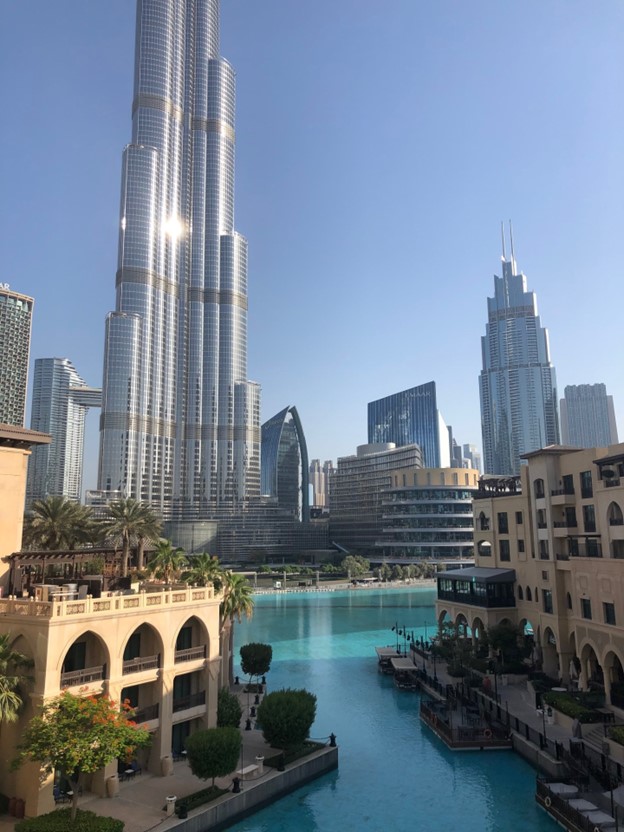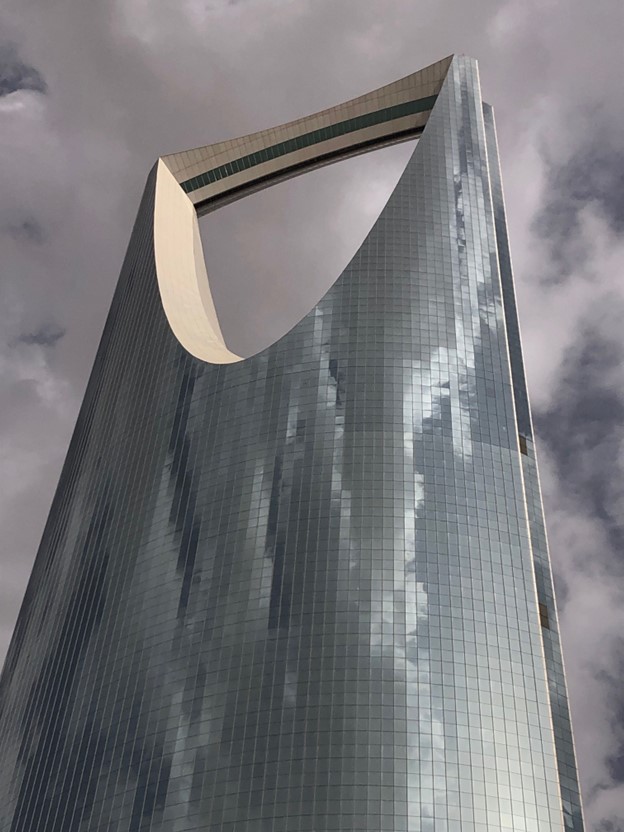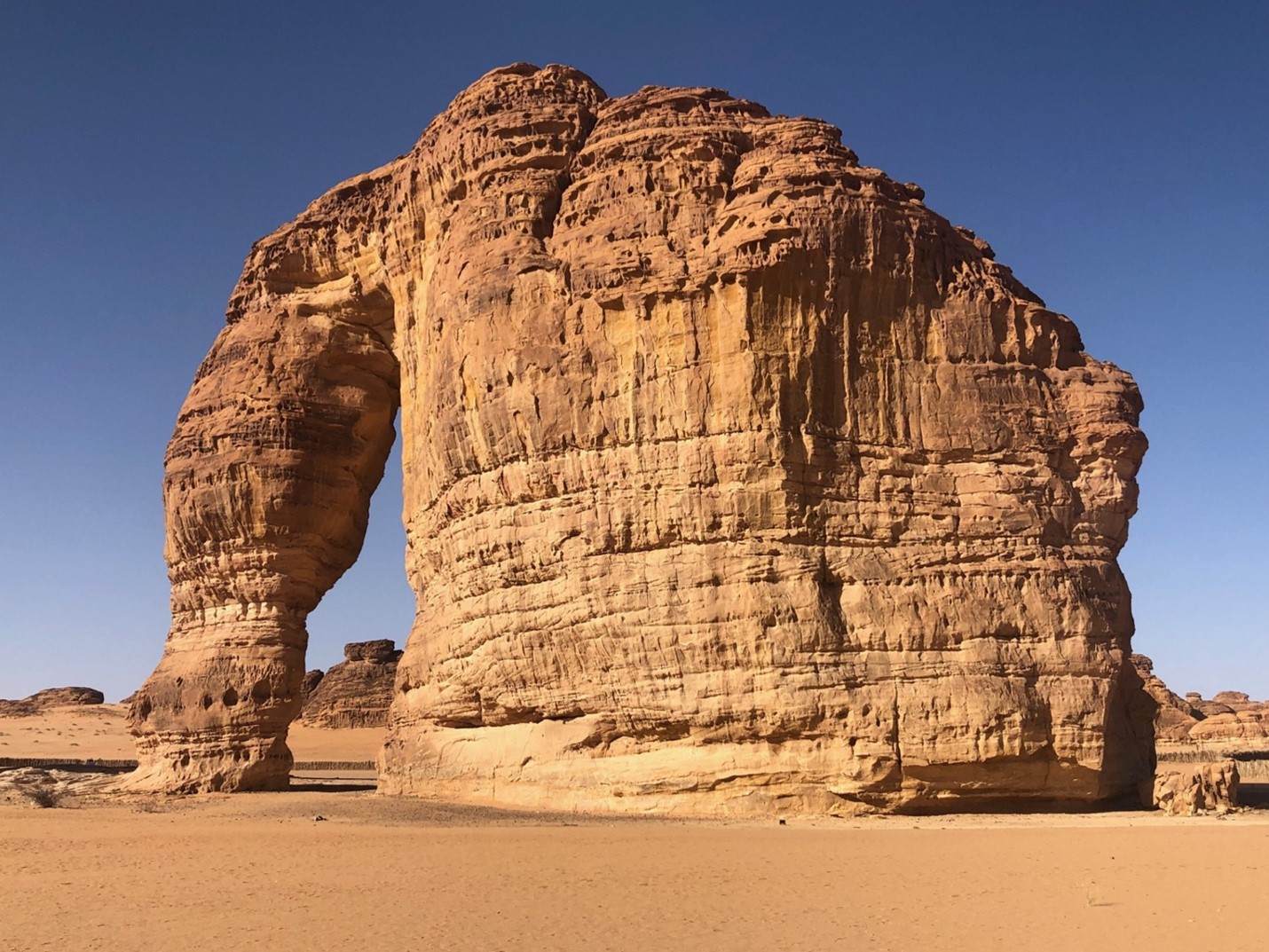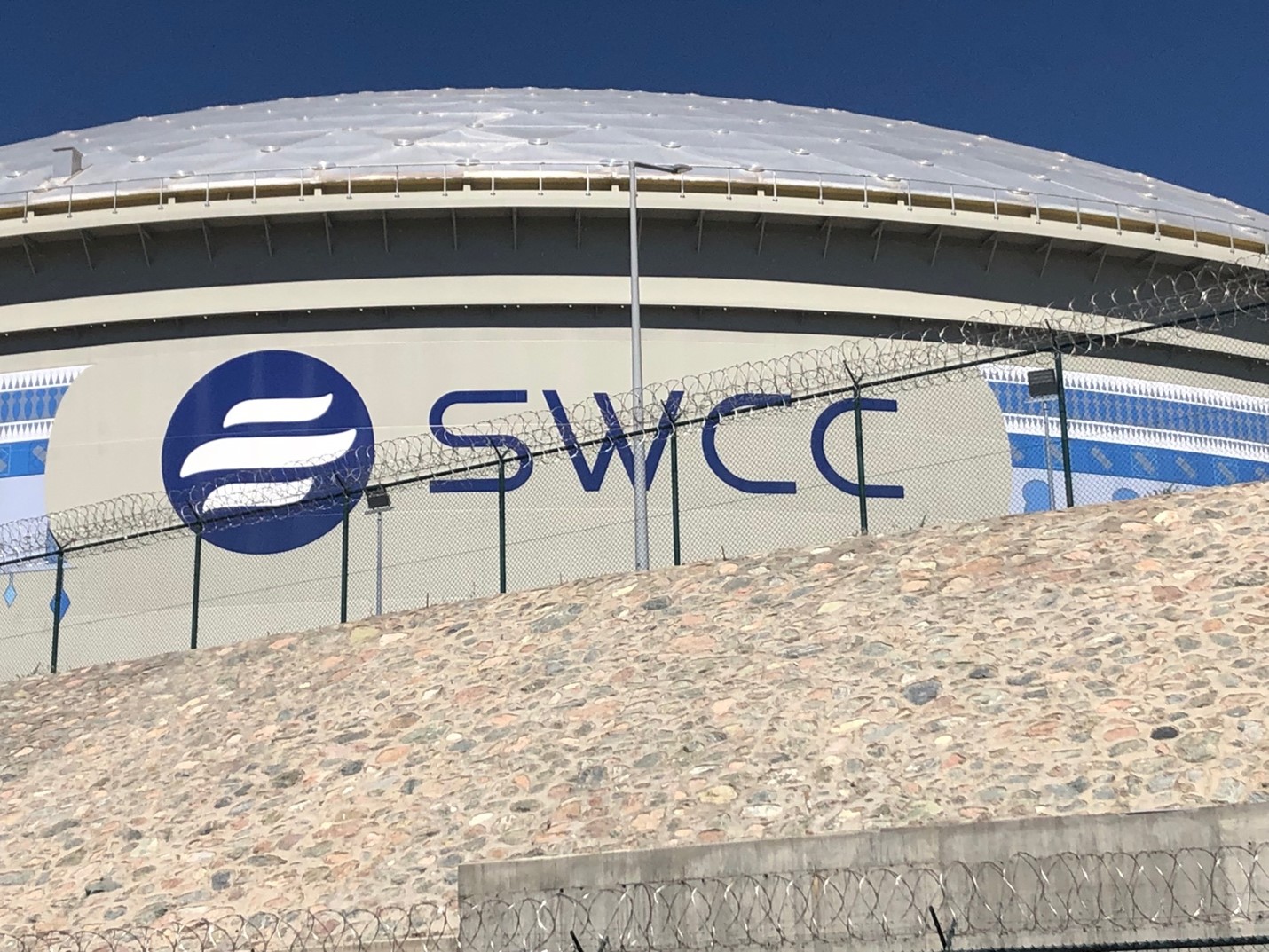Christopher Low: 2023-25 Environmental Humanities Research Professor
Dr. Christopher Low is an Assistant Professor in the Department of History and he
is the the director of the Middle East Center. His research focus on water, desalination, carbon infrastructure, energy, and climate
change in the Middle East is part of a growing focus on global perspectives within
the environmental humanities. Provided below are the written answers to questions
posed by Danielle Endres, Director of Environmental Humanities during October, 2023.
[Photos by Christopher Low]
What project will you be working on for your Environmental Humanities Research Professorship?
During my tenure as Environmental Humanities Research Professor I will be working on my next book, tentatively titled
The Well and the Water Machine: Desalination, Carbon Infrastructures, and Climate
Risk in the Arabian Peninsula. This project traces the Arabian Peninsula’s transformation from a pre-colonial/pre-industrial
world of traditional infrastructures like wells, aqueducts, and aflaj irrigation systems to a society almost wholly dependent on the “black magic” of turning
oil revenues and seawater into freshwater. Particularly since the latter half of the
twentieth century, the petro-kingdoms of the Arabian Peninsula have conquered their
existential water issues through the adoption of large-scale desalination projects.
In turn, fossil fuels have become the key ingredients in the manufacture of water.
Mirroring the region’s ethos of endless energy, desalination has fueled an equally
problematic environmental imaginary of “infinite water,” obscuring the region’s acute
vulnerability to water scarcity and climate change. Despite this intimate relationship,
while scholars have easily identified the importance of the region’s oil pipelines
as the lifeblood of glittering cities like Abu Dhabi, Dubai, Doha, Jeddah and Riyadh,
the tubes, valves, membranes, and pipes of their desalination plants have been left
strangely understudied by historians. [Photo: Burj Khalifa, Dubai]
Humanities Research Professor I will be working on my next book, tentatively titled
The Well and the Water Machine: Desalination, Carbon Infrastructures, and Climate
Risk in the Arabian Peninsula. This project traces the Arabian Peninsula’s transformation from a pre-colonial/pre-industrial
world of traditional infrastructures like wells, aqueducts, and aflaj irrigation systems to a society almost wholly dependent on the “black magic” of turning
oil revenues and seawater into freshwater. Particularly since the latter half of the
twentieth century, the petro-kingdoms of the Arabian Peninsula have conquered their
existential water issues through the adoption of large-scale desalination projects.
In turn, fossil fuels have become the key ingredients in the manufacture of water.
Mirroring the region’s ethos of endless energy, desalination has fueled an equally
problematic environmental imaginary of “infinite water,” obscuring the region’s acute
vulnerability to water scarcity and climate change. Despite this intimate relationship,
while scholars have easily identified the importance of the region’s oil pipelines
as the lifeblood of glittering cities like Abu Dhabi, Dubai, Doha, Jeddah and Riyadh,
the tubes, valves, membranes, and pipes of their desalination plants have been left
strangely understudied by historians. [Photo: Burj Khalifa, Dubai]
 Having just returned from a pair of research trips to Saudi Arabia and Qatar this
spring and summer, I will be working on a pair of book chapters/articles focusing
on the life and work of Mohammed bin Faisal Al Saud. The late Prince Mohammed was
the founding father of Saudi Arabia’s modern desalination industry. I argue that his
work in the 1960s and 1970s paved the way for the rise of the Saline Water Conversion
Corporation, making the Kingdom the largest producer of desalinated water in the world.
[Photo: Kingdom Tower, Riyadh]
Having just returned from a pair of research trips to Saudi Arabia and Qatar this
spring and summer, I will be working on a pair of book chapters/articles focusing
on the life and work of Mohammed bin Faisal Al Saud. The late Prince Mohammed was
the founding father of Saudi Arabia’s modern desalination industry. I argue that his
work in the 1960s and 1970s paved the way for the rise of the Saline Water Conversion
Corporation, making the Kingdom the largest producer of desalinated water in the world.
[Photo: Kingdom Tower, Riyadh]
I’m also writing another interrelated piece on his ill-fated scheme to tow icebergs from Antarctica to Saudi Arabia. While the “Water Prince” is often lampooned for this eccentric backup plan to his desalination projects, I argue that this well-worn anecdote has unfairly detracted from his pivotal role in the development of Saudi Arabia and the entire Gulf region. In both cases, there are more interesting ways that both Prince Mohammed’s desalination interests and his fascination with icebergs are deeply tied to his formative student days in California and his exposure to the American West’s perennial fears that eventually the Colorado River will be overtaxed.
On a side note, I had the opportunity to visit Saudi Arabia’s newly marketed tourist destination, the UNESCO World Heritage Site at Al ‘Ula. Wandering among the red rocks, arches, and oases of Al ‘Ula one cannot help feeling some sort of strange kinship between the arid landscapes of Utah and Arizona and northwestern Saudi Arabia. [Photo: Al ‘Ula, Saudi Arabia]
 This summer I was lucky enough to have been given access to more than a dozen boxes
of Mohammed bin Faisal’s personal papers. I was also able to discuss his legacy with
his daughter Princess Maha bint Mohammed Al Faisal. Through her kindness and the assistance
of the King Faisal Center for Research and Islamic Studies, I now have a treasure
trove of documents and local Arabic-language histories to draw upon. The Environmental
Humanities Research Professorship will give me the time and space to write these parts
of my wider project and to craft a book proposal.
This summer I was lucky enough to have been given access to more than a dozen boxes
of Mohammed bin Faisal’s personal papers. I was also able to discuss his legacy with
his daughter Princess Maha bint Mohammed Al Faisal. Through her kindness and the assistance
of the King Faisal Center for Research and Islamic Studies, I now have a treasure
trove of documents and local Arabic-language histories to draw upon. The Environmental
Humanities Research Professorship will give me the time and space to write these parts
of my wider project and to craft a book proposal.
Your research focus on water, desalination, carbon infrastructure, energy, and climate change in the Middle East is part of a growing focus on global perspectives within the environmental humanities. Why is a global perspective, particularly from a middle east studies vantage point, important for the environmental humanities?
As a Middle East historian, the ubiquity of associations between the Middle East and oil are often depressing and numbingly monotonous. Despite this never-ending supply of (often bad) petro-state history, there is remarkably little work that addresses the history and future of climate change in the region. And while there are stacks of scholarly works on the Nile, Tigris, and Euphrates, including some very fine environmental histories, the environmental history of water in Saudi Arabia and the wider Gulf lacks any permanent river to feature as the main character. Similarly, while desalination’s importance in the Arabian Peninsula and more globally is rapidly growing, the relative novelty of large-scale desalination projects means that there is exceedingly little scholarship exploring its history. In comparison to other water infrastructures like big dam projects in the United States or globally, desalination simply hasn’t been given the attention that it deserves.
I’m also attracte d to desalination in the Middle East as a vehicle for thinking about dilemmas facing
the oil-rich states of the region. Desalination is massively fossil-fuel intensive
and expensive to maintain. Thus, even if rest of the world were to begin taking climate
change more seriously, the Gulf has an existential imperative to continue producing
oil and natural gas both as the means to fuel and fund its access to man-made freshwater.
And even while desalination is a key contributor to carbon-intensive lifestyles in
the region, it is frequently positioned as a “green” solution to the looming challenges
of heat and water scarcity in the region. Without a more nuanced understanding of
the local environmental, economic, and political conditions driving this region’s
decision making, abstract discussions of carbon emissions reductions at the global
level seem dangerously disconnected from the on-the-ground realities of the very region
at the heart of both fossil fuel extraction and increasingly poised to shape the uncertain
future of international decarbonization efforts.
d to desalination in the Middle East as a vehicle for thinking about dilemmas facing
the oil-rich states of the region. Desalination is massively fossil-fuel intensive
and expensive to maintain. Thus, even if rest of the world were to begin taking climate
change more seriously, the Gulf has an existential imperative to continue producing
oil and natural gas both as the means to fuel and fund its access to man-made freshwater.
And even while desalination is a key contributor to carbon-intensive lifestyles in
the region, it is frequently positioned as a “green” solution to the looming challenges
of heat and water scarcity in the region. Without a more nuanced understanding of
the local environmental, economic, and political conditions driving this region’s
decision making, abstract discussions of carbon emissions reductions at the global
level seem dangerously disconnected from the on-the-ground realities of the very region
at the heart of both fossil fuel extraction and increasingly poised to shape the uncertain
future of international decarbonization efforts.
[Photo: Saline Water Conversion Corporation Tanks, Taif, Saudi Arabia]
You will be teaching a Global Environmental History Graduate Seminar in Spring 2024 that will be cross-listed between History and Environmental Humanities. Please tell readers more about this course.
Yes, I’m really excited about this course. Between the Department of History, the American West Center, and Environmental Humanities, the University of Utah has an embarrassment of riches related to environmental topics. However, for obvious reasons, those strengths tend to cluster around American topics, especially questions related to Native American voices, the Mountain West, Utah, and adjacent states. While this gives our programs a strong identity, students and faculty in environmental history and the environmental humanities are increasingly asked to grapple with the ways in which more local environmental concerns are affected by seemingly distant environmental changes taking places at transnational, transregional, and even global scales.
This course [EHUM 6850/HIST 7670] seeks to introduce students to the ways in which American environmental historians contributed to the rise of environmental history writing beyond the United States and Europe. On the one hand, the course introduces students to cutting-edge works exploring other a variety of world regions from Latin America, Africa, the Middle East, and Asia to polar regions like Antarctica. This broader exposure prepares students to teach non-US environmental courses and to be more open to taking advantage of exciting methodological developments unfolding beyond their home areas of specialization.
On the other hand, this course also really thinks seriously about how historians and humanists must grapple with unfamiliar geographical and temporal scales. While thoughtful students will immediately understand that climate change is a global or planetary question, most will not have any training that would prepare them to write about issues at these scales. Likewise, as environmental historians and humanists grapple with debates surrounding the periodization of climate change, increasingly definitions of the Anthropocene and competing theoretical frameworks simultaneously force us to consider both the entire planet and expand our conception of time from more conventional chunks like decades and centuries to the billions of years required the “deep time” of geological scales.
Thus, while humanists have a critical role in narrating the human and non-human agents of climate change, we also face unprecedented changes to the demands placed on our disciplinary and methodological toolkits. And while some of our work as historians might take place in the sheltered coves of our disciplinary specialisms, writing and teaching the stories of global climate change often finds us wading into unfamiliar waters. This requires us to engage with, collaborate alongside, and even compete with scientists, journalists, and writers of fiction in exciting and dauntingly novel ways.
Outside of your professorship and teaching, what do you like to do in your free time?
Mostly, I’m happy to be outside with my partner and our two daughters, where we can all avoid staring at phones and other screens. Moving to Utah has been something of dream come true. For most of my adult life, the hiking and scenery of the Intermountain West have been recurrent vacation draws for us. Last year’s move from my previous appointment at Iowa State University, a painfully flat place, provided a dramatic elevation in my topographical satisfaction with life in general. As a basketball fan, I’m also loving the ability to walk downtown to catch Jazz games.
As a scholar of the Middle East and Islamic world by training, I’m also still an itchy-footed traveler, though increasingly guilty about my carbon consumption. I’ve been lucky enough to study languages and work in archives from London to Yemen and Istanbul to the United Arab Emirates. As a result, I have a rotating cast of homes-away-from-home, neighborhood haunts, bookstores, and cuisines that I’m always missing ever so slightly. I’m certain that I’ll be back in Saudi Arabia soon, but I’d also like to make it to Oman in the next year as well.
Categories
Featured Posts
Tag Cloud
- community engagement (12)
- outdoor recreation (2)
- outreach (1)
- alumni (3)
- admissions (1)
- faculty (8)
- practitioner-in-residence (2)
- cultural anthropology (1)
- utah award in the environmental humanities (1)
- environmental justice (2)
- STEMCAP (2)
- STEM (2)
- water (1)
- communications (2)
- humanities (1)
- Taft-Nicholson Center (1)
- director (3)
- student (5)
- API (1)
- Asian American (1)
- Pacific Islander (1)
- graduation (1)
- research (3)
- thesis (1)
- project (1)
- Indigenous (1)
- Shoshone (1)
- Great Salt Lake (2)
- Bear River (1)
- land acknowledgement (1)
- STEMAP (1)
- public engagement (1)
- science (1)
- science communication (1)
- Wilkes Center (1)
- climate change (1)
- climate science (1)
- climate policy (1)
- policymaking (1)
- funding (1)
- storytelling (1)
- radio (1)
- journalism (1)
- racial justice (1)
- outdoor education (1)
- writing (1)
- non-fiction (1)
- energy extraction (1)
- reading (1)
- environmental education (1)
- affect theory (1)
- media (1)
- rhetoric (1)
